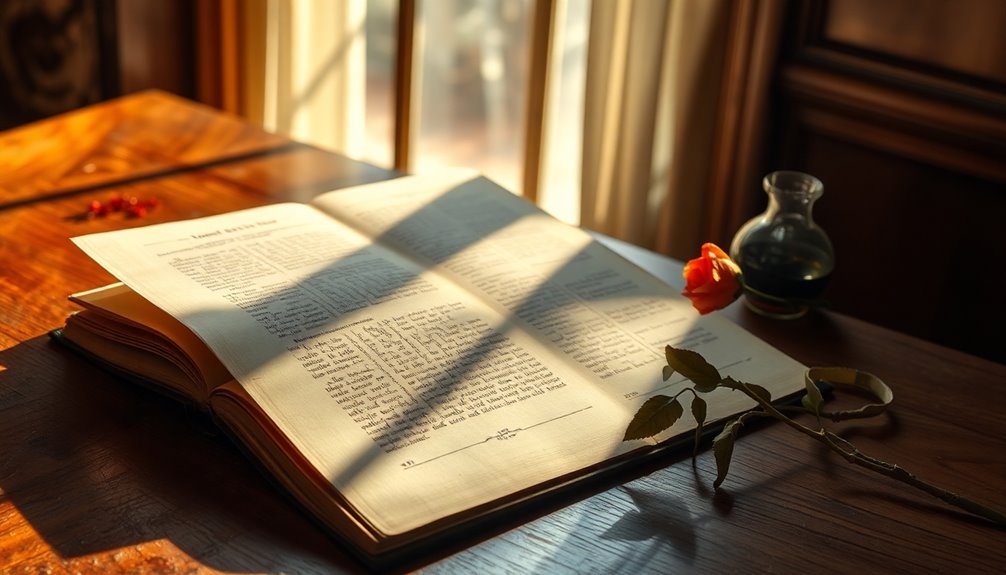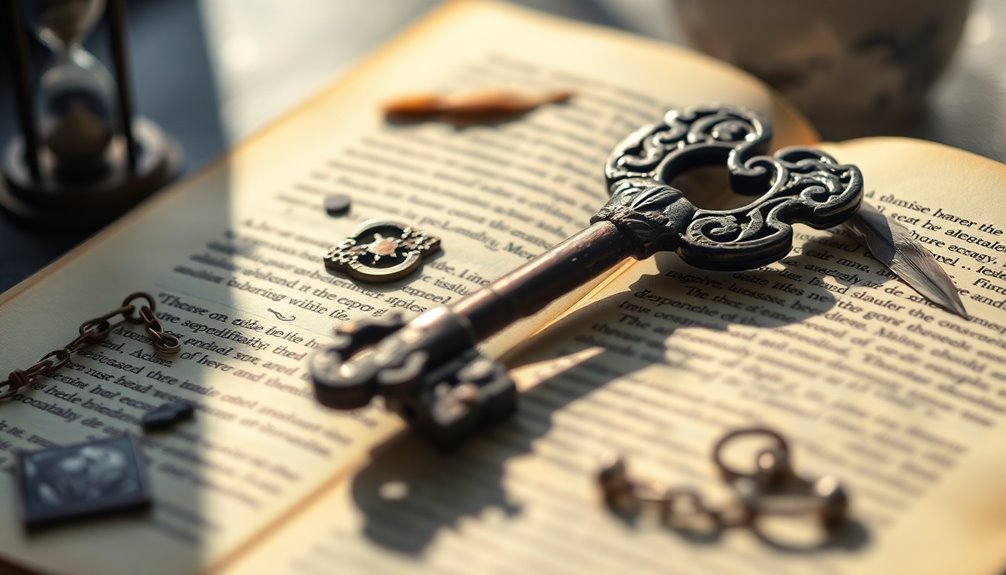Symbolism isn't a theme, but it's super important for telling stories! Think of symbolism as the colorful pieces of a puzzle that bring themes to life. Symbols like objects or characters can show big ideas and feelings, helping you connect deeper with the story. They illustrate the theme, which is the main message or idea behind a tale. Together, they guide you through the characters' journeys and emotions. So, while symbolism and theme are different, they work hand in hand to create a rich experience. Stick around, and you'll discover even more about how they connect and enhance storytelling!
Key Takeaways
- Symbolism and theme are distinct elements; symbolism uses symbols to illustrate deeper themes within a narrative.
- Themes represent the central ideas or messages, while symbols are individual pieces that contribute to those ideas.
- Effective symbolism enhances emotional engagement and reinforces the themes of a narrative through character interactions.
- Symbols can have multiple interpretations, enriching the thematic exploration and revealing deeper emotional states.
- Understanding the difference between symbolism and theme improves comprehension and appreciation of literary works.
Defining Symbolism and Theme

Throughout literature, symbolism plays an essential role in conveying deeper meanings, while themes serve as the backbone of a narrative's message. You might wonder what these terms really mean. Well, symbolism refers to using symbols—like objects or characters—to represent ideas or concepts. These symbols can open up exciting symbolism possibilities that go beyond their literal meaning. For example, a dove might symbolize peace, adding layers to a story.
On the other hand, a theme is the central idea or message of a story. It explores universal human experiences, like love or friendship, that resonate with readers. While symbolism helps illustrate these themes, it's important to remember that they aren't the same. Symbols reinforce the themes, creating a richer experience as you read.
Think of a story as a puzzle. The theme is the picture you see when it's complete, while the symbols are the individual pieces that help you get there. Understanding this distinction is vital for really digging into a narrative.
The Relationship Between Symbolism and Theme

Symbols and themes are like best friends in a story, working together to create meaning.
When you spot a symbol, it often connects to a bigger theme, helping you understand the story on a deeper level.
Plus, the way characters interact with these symbols can make the narrative even more exciting and meaningful!
Symbolic Representation of Themes
In literature, the interplay between symbolism and theme enriches the reader's understanding of a narrative's deeper meanings. Symbolism serves as a powerful tool that helps you grasp complex ideas and emotions. When you encounter a symbol in a story, it often represents an abstract theme, making the theme more tangible. For example, a rose might symbolize love, helping you feel the depth of that theme.
The relationship between symbolism and theme is like a dance. Symbols often reinforce themes, while themes give you clues to interpret symbols. This back-and-forth connection creates a richer experience in reading. As you explore a text, you might find that symbols enhance your emotional connection, allowing you to engage with the story on a deeper level.
When you analyze how symbols represent themes, you uncover the author's intent, making the reading journey even more exciting. You start to see how every symbol has a purpose, guiding you through the narrative.
Enhancing Narrative Through Symbols
The relationship between symbolism and theme greatly enhances a narrative's impact, allowing readers to uncover layers of meaning that might otherwise remain hidden. Symbols serve as powerful tools that connect complex themes to concrete images. This connection creates a richer understanding for you, the reader.
Here are three ways symbols enhance a narrative:
- Emotional Connection: Symbols link to specific themes, making messages more personal and relatable. You can feel the story on a deeper level.
- Recurring Motifs: When symbols appear throughout the story, they reinforce themes. Their repeated presence reminds you of the main ideas, helping you remember them.
- Universal Concepts: Effective symbols often evoke ideas that resonate with everyone. You might find parallels between the narrative's themes and your own life experiences, enriching your reading journey.
Interplay Between Characters and Symbols
Characters and symbols intertwine to create a dynamic relationship that deepens the thematic exploration of a narrative. When you read a story, you might notice how symbols stand for big ideas. These symbols help you connect with the characters and understand their journeys. For example, a character's favorite object might reveal their hopes or fears. This connection lets you dive deeper into their emotional states.
As characters interact with symbols, you see their personal struggles reflected back. Each time a symbol appears, it can remind you of what the character is facing, making the themes more powerful and clear. You might even find that certain symbols repeat throughout the story, guiding you through the characters' arcs and helping you grasp the themes better.
Analyzing how characters engage with symbols can uncover many layers of meaning. This exploration allows you to interpret the story in different ways, adding richness to your reading experience.
Importance of Symbolism in Literature

Literature's power often lies in its ability to convey complex ideas through symbolism. Symbolism enriches stories, making them more exciting and meaningful. When you recognize symbols, you connect with the themes and messages on a deeper level.
Here are three key reasons why symbolism is important in literature:
- Multiple Interpretations: Symbols allow for various meanings, letting readers explore different themes and ideas. This opens up a world of possibilities!
- Emotional Engagement: Effective symbolism touches your heart, helping you feel the story's impact. It makes characters and events resonate, leaving a lasting impression.
- Character Development: Symbols link personal experiences to larger themes, revealing more about characters. You can better understand their journeys and struggles.
Symbolism as a Narrative Device

Symbolism enriches narratives by translating abstract concepts into tangible elements that resonate with readers. When authors use symbolism, they represent big ideas through objects, characters, or actions. This makes stories deeper and more meaningful. Imagine reading a book where a simple tree symbolizes growth. You can feel the character's journey as they change, just like the tree.
Effective symbols can pull at your emotions. They create connections between characters and the themes of the story, making it easier for you to engage with the plot. Authors often introduce symbols early, so you notice them throughout the story. This repetition helps you grasp important messages and adds excitement to your reading.
As you follow the characters, their interactions with symbols reveal their growth and struggles. Maybe a character's broken watch represents lost time, showing their transformation.
With symbolism, writers share complex ideas without lengthy explanations. Instead, they invite you to explore and find meaning in the narrative yourself. So, the next time you read, pay attention! You might uncover a world of symbolism that brings the story to life in ways you never imagined. Happy reading!
Examples of Symbolism Enhancing Themes

Let's explore how symbolism can help us understand characters and themes better!
When you see a symbol, like the mockingjay in "The Hunger Games," it often represents something much bigger, like freedom or rebellion.
These symbols not only add depth to the story but also connect to universal themes that everyone can relate to.
Symbolism in Character Development
When characters embody powerful symbols, they often resonate with readers on a deeper emotional level, enhancing the overall themes of the narrative.
Symbolism in character development can help you connect with the story in exciting ways. Here are three examples of how this works:
- In Maria V. Snyder's "Poison Study," butterflies symbolize freedom and personal transformation, reflecting the main character's growth.
- In "The Hunger Games," the mockingjay represents rebellion and resilience, mirroring Katniss Everdeen's journey as she fights against oppression.
- In "The Great Gatsby," the green light symbolizes unattainable dreams, representing Gatsby's longing for Daisy and his struggles with reality.
These symbols help you understand the characters' inner worlds and their values. Additionally, much like the urban themes in contemporary Indian painting, symbolism in literature can explore complex socio-political issues, enriching character arcs and themes.
When characters interact with these symbols, it reveals their beliefs and personal experiences. This connection deepens your emotional engagement with the story.
As you explore their journeys, you'll see how symbolism enhances character development, making themes even richer.
Universal Symbols and Themes
Many universal symbols resonate across cultures, enhancing the themes in literature by providing relatable imagery. For instance, light often represents knowledge, helping readers connect with themes of enlightenment and discovery. In "The Great Gatsby," the green light symbolizes unattainable dreams, emphasizing the idea of the elusive American Dream. You can see how easily these symbols draw you into the story!
In "To Kill a Mockingbird," the mockingbird stands for innocence, highlighting themes of racial injustice and moral growth. This universal symbol makes it easier to understand the story's deeper messages.
Water is another universal symbol, representing life and renewal. In "The Old Man and the Sea," it enhances themes of transformation and rebirth, making the narrative more impactful.
Moreover, in "The Hunger Games," the mockingjay symbolizes rebellion and hope. This adds weight to themes of resistance against oppression and the fight for freedom.
Types of Symbols and Their Meanings

Symbolism enriches literature by allowing deeper connections to themes through various types of symbols. You'll find that different symbols serve unique purposes, adding layers of meaning to stories you read.
Here are three main types of symbols and their meanings:
- Universal Symbols: These symbols, like light representing knowledge, are understood across cultures. They help everyone connect to the themes in a story.
- Cultural Symbols: Objects such as flags can evoke feelings of national pride and identity. They resonate with readers, bringing a shared sense of belonging and understanding.
- Personal Symbols: Sometimes, you'll encounter items that hold special meaning for specific characters. For instance, a locket could symbolize family bonds. This deepens your emotional connection to the story.
There are also allegorical and contextual symbols, which illustrate complex themes and provide immediate significance to the plot.
Techniques for Effective Symbolism

To create powerful symbols in your story, start by introducing them early on. This helps readers connect with their importance right away.
Also, using recurring motifs can really highlight key themes and show how characters grow throughout the tale.
Early Symbol Introduction
In the early stages of a narrative, the introduction of symbols plays an essential role in shaping the reader's understanding and emotional engagement. When authors introduce symbols early, they create a strong foundation that connects to deeper themes later in the story.
You'll notice that early symbol introduction allows you to form initial interpretations that can grow and change as the story unfolds. Here are three key benefits of introducing symbols early:
- Establishes Relevance: Symbols set the stage for future connections, making their meanings clear as the plot develops.
- Foreshadowing: By presenting symbols at the beginning, authors guide your expectations, hinting at their importance in the story.
- Enhances Cohesiveness: Early symbols link plot events to themes, making the overall narrative feel more unified and satisfying.
Recurring Motif Usage
As a story progresses, the introduction of recurring motifs amplifies the impact of earlier symbols, reinforcing themes and deepening emotional connections. Imagine a special object, like a locket, appearing again and again throughout the tale. Each time you see it, it reminds you of important moments. These recurring motifs serve as thematic reminders, helping you remember the story's central message.
When writers use recurring motifs, they create a cohesive structure. You can easily connect different elements and themes, making the story feel united. These motifs also enhance emotional engagement, helping you understand the characters' journeys better. For instance, when a character faces challenges, seeing the motif again can evoke reflections on how they've grown.
The best part? Subtlety is key! By presenting recurring motifs without over-explaining, writers allow you to interpret their significance. This invites you to engage more actively with the story, making your reading experience richer.
Common Mistakes in Symbolism Usage

Symbolism can add depth to a story, but many writers stumble with its usage, leading to a muddled narrative. You don't want your symbols to confuse readers or dilute your story's meaning.
Here are some common mistakes in symbolism usage to watch out for:
- Overusing symbols: When you use too many, their meanings can get lost. This makes it hard for readers to grasp your message.
- Relying on clichés: Using tired symbols instead of creating original ones can make your story feel boring. Readers love fresh ideas, so think outside the box!
- Losing track of symbol significance: Symbols can change meaning throughout your story. If you don't keep up with these shifts, you risk losing emotional impact and thematic connections.
Analyzing Symbolism in Classic Literature

Writers can learn a lot from how classic literature employs symbolism to convey profound themes. These symbols often hold deep meanings, making stories richer and more enjoyable.
For instance, in "To Kill a Mockingbird," the mockingbird symbolizes innocence, highlighting the pain caused by racial injustice. Similarly, in Herman Melville's "Moby-Dick," the white whale represents obsession and humanity's struggle against nature, inviting you to think about your own challenges.
F. Scott Fitzgerald's "The Great Gatsby" features the green light, which symbolizes Gatsby's dreams that seem just out of reach. This symbol deepens the theme of aspiration and the elusive American Dream.
In Nathaniel Hawthorne's "The Scarlet Letter," the letter "A" symbolizes sin and shame, linking to themes of guilt and societal judgment.
The Impact of Symbols on Reader Interpretation

Symbols play an essential role in shaping how you interpret a narrative, transforming abstract themes into tangible elements you can relate to. They help you connect with stories in deeper ways, making everything more exciting!
When you spot symbols, you can understand the story's message better. Here are three key impacts of symbols on your reading experience:
- Visual Connections: Symbols turn complex ideas into relatable images, helping you see themes clearly.
- Emotional Engagement: When symbols recur, they deepen your feelings about the story, making the themes more personal.
- Varied Interpretations: Since symbols can mean different things to different people, they invite you to think about your own experiences and culture while interpreting the narrative.
Frequently Asked Questions
Is Symbolism a Literary Theme?
Symbolism isn't a literary theme, but it plays a big role in stories! Symbols are objects or ideas that represent something deeper. They help you connect with the themes, like love or friendship, in a more meaningful way.
For example, a heart can symbolize love. By recognizing these symbols, you'll discover richer meanings in the story.
Are Symbolism and Theme the Same Thing?
You might think symbolism and theme are the same thing, but they're not!
A theme is like the big idea of a story, while symbolism uses specific objects or actions to show that idea. For example, a dove might symbolize peace.
Isn't that cool? So, while themes give us the message, symbols help us see and feel it in a fun, concrete way.
They work together to make stories even more exciting!
What Is an Example of a Symbolic Theme?
A great example of a symbolic theme is found in "To Kill a Mockingbird."
Here, the mockingbird represents innocence. This symbol helps show the theme of protecting those who are vulnerable.
Just like you wouldn't harm a mockingbird, the story teaches us to stand up for the innocent.
It's exciting to see how symbols can reveal deeper messages in stories, making them even more meaningful and fun to explore!
What Are Themes and Examples?
Imagine themes as the heartbeats of a story, pulsing with meaning and emotion. Themes are the big ideas that connect to our lives, like love, friendship, or bravery.
For example, in "The Lion King," the theme of responsibility shines through Simba's journey.
Another example is the theme of courage in "Harry Potter," where Harry faces his fears.
Themes help you dive deeper into stories, making each page a new adventure waiting to unfold!
Conclusion
In the grand tapestry of stories, symbolism weaves a delightful thread that brings themes to life. It's like a secret code, revealing deeper meanings and inviting you to explore. By using symbols, authors can gently guide you to see the world through new eyes. So, next time you plunge into a book, keep an eye out for those hidden treasures! They're not just decorations; they're the heartbeat of the story, making your reading adventure even more exciting!











